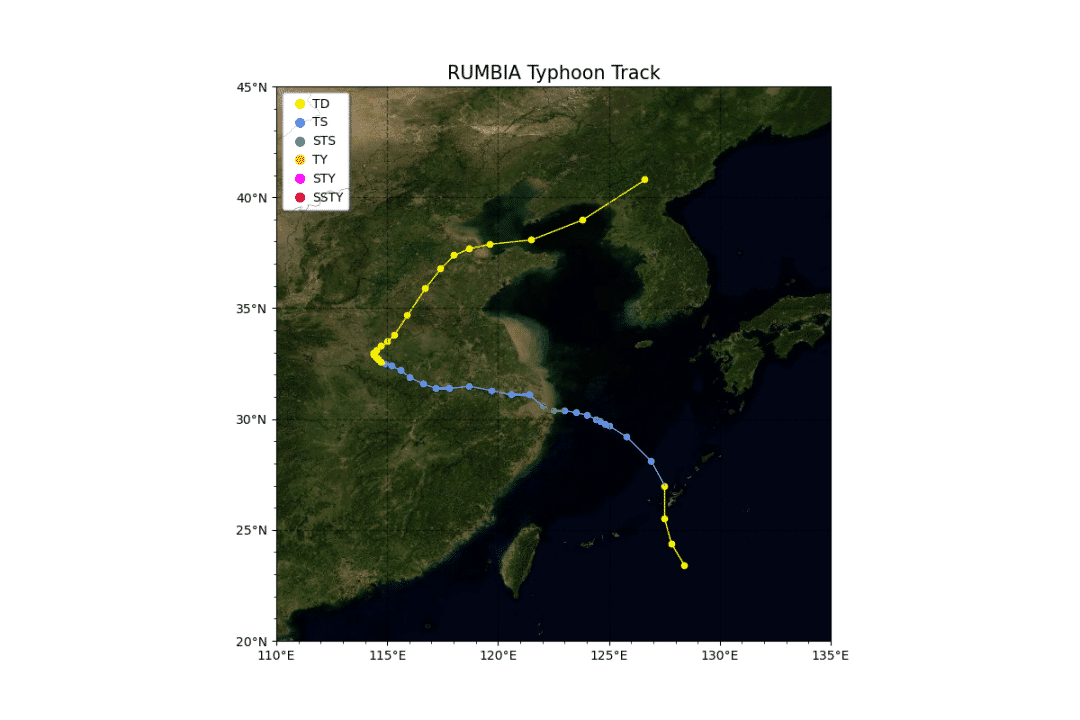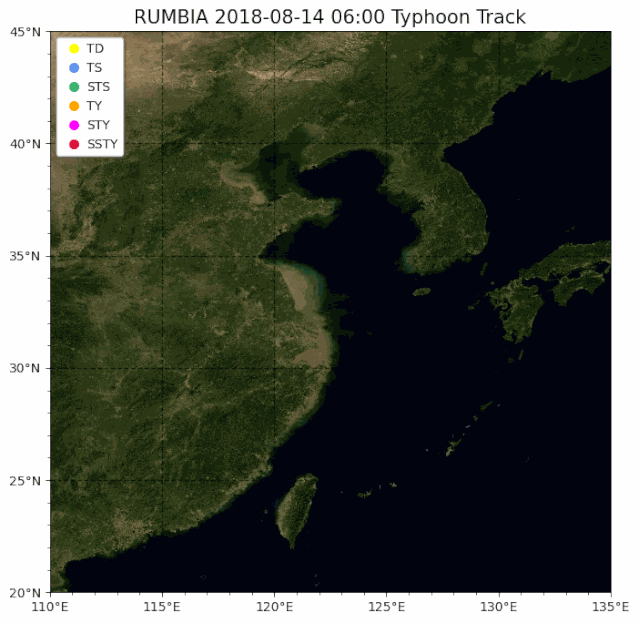Python繪圖實(shí)現(xiàn)臺(tái)風(fēng)路徑可視化代碼實(shí)例
臺(tái)風(fēng)是重大災(zāi)害性天氣,臺(tái)風(fēng)引起的直接災(zāi)害通常由三方面造成,狂風(fēng)、暴雨、風(fēng)暴潮,除此以外臺(tái)風(fēng)的這些災(zāi)害極易誘發(fā)城市內(nèi)澇、房屋倒塌、山洪、泥石流等次生災(zāi)害。正因如此,臺(tái)風(fēng)在科研和業(yè)務(wù)工作中是研究的重點(diǎn)。希望這次臺(tái)風(fēng)路徑可視化可以給予大家一點(diǎn)點(diǎn)幫助。
臺(tái)風(fēng)路徑的獲取
中國(guó)氣象局(CMA)
中國(guó)氣象局(CMA)的臺(tái)風(fēng)最佳路徑數(shù)據(jù)集(BST),BST是之后對(duì)歷史臺(tái)風(fēng)路徑進(jìn)行校正后發(fā)布的,其經(jīng)緯度、強(qiáng)度、氣壓具有更高的可靠性,但是時(shí)間分辨率為6小時(shí),部分3小時(shí),這一點(diǎn)不如觀測(cè)數(shù)據(jù)。下載地址:
http://tcdata.typhoon.org.cn/
溫州臺(tái)風(fēng)網(wǎng)
溫州臺(tái)風(fēng)網(wǎng)的數(shù)據(jù)是實(shí)時(shí)發(fā)布數(shù)據(jù)的記錄,時(shí)間分辨率最高達(dá)1小時(shí),對(duì)于臺(tái)風(fēng)軌跡具有更加精細(xì)化的表述。下載地址:
http://www.wztf121.com/
示例
導(dǎo)入模塊并讀取數(shù)據(jù),使用BST的2018年臺(tái)風(fēng)路徑數(shù)據(jù)作為示例,已經(jīng)將原始的txt文件轉(zhuǎn)換為xls文件。
import os, globimport pandas as pdimport numpy as npimport shapely.geometry as sgeomimport matplotlib.pyplot as pltfrom matplotlib.image import imreadfrom matplotlib.animation import FuncAnimationimport matplotlib.lines as mlinesimport cartopy.crs as ccrsimport cartopy.feature as cfeatfrom cartopy.mpl.ticker import LongitudeFormatter,LatitudeFormatterimport cartopy.io.shapereader as shpreaderimport cartopy.io.img_tiles as cimgtfrom PIL import Imageimport warnings warnings.filterwarnings(’ignore’)df = pd.read_csv(’./2018typhoon.csv’)
定義等級(jí)色標(biāo)
def get_color(level): global color if level == ’熱帶低壓’ or level == ’熱帶擾動(dòng)’: color=’#FFFF00’ elif level == ’熱帶風(fēng)暴’: color=’#6495ED’ elif level == ’強(qiáng)熱帶風(fēng)暴’: color=’#3CB371’ elif level == ’臺(tái)風(fēng)’: color=’#FFA500’ elif level == ’強(qiáng)臺(tái)風(fēng)’: color=’#FF00FF’ elif level == ’超強(qiáng)臺(tái)風(fēng)’: color=’#DC143C’ return color
定義底圖函數(shù)
def create_map(title, extent): fig = plt.figure(figsize=(12, 8)) ax = fig.add_subplot(1, 1, 1, projection=ccrs.PlateCarree()) url = ’http://map1c.vis.earthdata.nasa.gov/wmts-geo/wmts.cgi’ layer = ’BlueMarble_ShadedRelief’ ax.add_wmts(url, layer) ax.set_extent(extent,crs=ccrs.PlateCarree()) gl = ax.gridlines(draw_labels=False, linewidth=1, color=’k’, alpha=0.5, linestyle=’--’) gl.xlabels_top = gl.ylabels_right = False ax.set_xticks(np.arange(extent[0], extent[1]+5, 5)) ax.set_yticks(np.arange(extent[2], extent[3]+5, 5)) ax.xaxis.set_major_formatter(LongitudeFormatter()) ax.xaxis.set_minor_locator(plt.MultipleLocator(1)) ax.yaxis.set_major_formatter(LatitudeFormatter()) ax.yaxis.set_minor_locator(plt.MultipleLocator(1)) ax.tick_params(axis=’both’, labelsize=10, direction=’out’) a = mlines.Line2D([],[],color=’#FFFF00’,marker=’o’,markersize=7, label=’TD’,ls=’’) b = mlines.Line2D([],[],color=’#6495ED’, marker=’o’,markersize=7, label=’TS’,ls=’’) c = mlines.Line2D([],[],color=’#3CB371’, marker=’o’,markersize=7, label=’STS’,ls=’’) d = mlines.Line2D([],[],color=’#FFA500’, marker=’o’,markersize=7, label=’TY’,ls=’’) e = mlines.Line2D([],[],color=’#FF00FF’, marker=’o’,markersize=7, label=’STY’,ls=’’) f = mlines.Line2D([],[],color=’#DC143C’, marker=’o’,markersize=7, label=’SSTY’,ls=’’) ax.legend(handles=[a,b,c,d,e,f], numpoints=1, handletextpad=0, loc=’upper left’, shadow=True) plt.title(f’{title} Typhoon Track’, fontsize=15) return ax
定義繪制單個(gè)臺(tái)風(fēng)路徑方法,并繪制2018年第18號(hào)臺(tái)風(fēng)溫比亞。
def draw_single(df): ax = create_map(df[’名字’].iloc[0], [110, 135, 20, 45]) for i in range(len(df)): ax.scatter(list(df[’經(jīng)度’])[i], list(df[’緯度’])[i], marker=’o’, s=20, color=get_color(list(df[’強(qiáng)度’])[i])) for i in range(len(df)-1): pointA = list(df[’經(jīng)度’])[i],list(df[’緯度’])[i] pointB = list(df[’經(jīng)度’])[i+1],list(df[’緯度’])[i+1] ax.add_geometries([sgeom.LineString([pointA, pointB])], color=get_color(list(df[’強(qiáng)度’])[i+1]),crs=ccrs.PlateCarree()) plt.savefig(’./typhoon_one.png’)draw_single(df[df[’編號(hào)’]==1818])

定義繪制多個(gè)臺(tái)風(fēng)路徑方法,并繪制2018年全年的全部臺(tái)風(fēng)路徑。
def draw_multi(df): L = list(set(df[’編號(hào)’])) L.sort(key=list(df[’編號(hào)’]).index) ax = create_map(’2018’, [100, 180, 0, 45]) for number in L: df1 = df[df[’編號(hào)’]==number] for i in range(len(df1)-1): pointA = list(df1[’經(jīng)度’])[i],list(df1[’緯度’])[i] pointB = list(df1[’經(jīng)度’])[i+1],list(df1[’緯度’])[i+1] ax.add_geometries([sgeom.LineString([pointA, pointB])], color=get_color(list(df1[’強(qiáng)度’])[i+1]),crs=ccrs.PlateCarree()) plt.savefig(’./typhoon_multi.png’)draw_multi(df)

定義繪制單個(gè)臺(tái)風(fēng)gif路徑演變方法,并繪制2018年第18號(hào)臺(tái)風(fēng)的gif路徑圖。
def draw_single_gif(df): for state in range(len(df.index))[:]: ax = create_map(f’{df['名字'].iloc[0]} {df['時(shí)間'].iloc[state]}’, [110, 135, 20, 45]) for i in range(len(df[:state])): ax.scatter(df[’經(jīng)度’].iloc[i], df[’緯度’].iloc[i], marker=’o’, s=20, color=get_color(df[’強(qiáng)度’].iloc[i])) for i in range(len(df[:state])-1): pointA = df[’經(jīng)度’].iloc[i],df[’緯度’].iloc[i] pointB = df[’經(jīng)度’].iloc[i+1],df[’緯度’].iloc[i+1] ax.add_geometries([sgeom.LineString([pointA, pointB])], color=get_color(df[’強(qiáng)度’].iloc[i+1]),crs=ccrs.PlateCarree()) print(f’正在繪制第{state}張軌跡圖’) plt.savefig(f’./{df['名字'].iloc[0]}{str(state).zfill(3)}.png’, bbox_inches=’tight’) # 將圖片拼接成動(dòng)畫(huà) imgFiles = list(glob.glob(f’./{df['名字'].iloc[0]}*.png’)) images = [Image.open(fn) for fn in imgFiles] im = images[0] filename = f’./track_{df['名字'].iloc[0]}.gif’ im.save(fp=filename, format=’gif’, save_all=True, append_images=images[1:], duration=500)draw_single_gif(df[df[’編號(hào)’]==1818])

以上就是本文的全部?jī)?nèi)容,希望對(duì)大家的學(xué)習(xí)有所幫助,也希望大家多多支持好吧啦網(wǎng)。
相關(guān)文章:
1. 父div高度不能自適應(yīng)子div高度的解決方案2. Java之JSP教程九大內(nèi)置對(duì)象詳解(中篇)3. CSS3實(shí)例分享之多重背景的實(shí)現(xiàn)(Multiple backgrounds)4. ASP中SELECT下拉菜單同時(shí)獲取VALUE和TEXT值的實(shí)現(xiàn)代碼5. servlet+jsp實(shí)現(xiàn)過(guò)濾器 防止用戶(hù)未登錄訪問(wèn)6. ASP錯(cuò)誤捕獲的幾種常規(guī)處理方式7. 利用XMLSerializer將對(duì)象串行化到XML8. 選擇模式 - XSL教程 - 29. JSP狀態(tài)管理的簡(jiǎn)單介紹10. 淺談XML Schema中的elementFormDefault屬性

 網(wǎng)公網(wǎng)安備
網(wǎng)公網(wǎng)安備